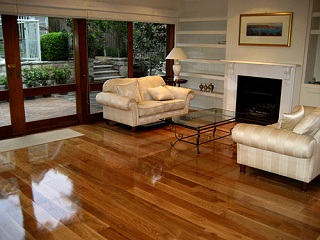
If you’re looking for the great look of hardwood floors without the installation challenges and limitations, then a floating hardwood floor may be exactly what you’ve been searching for. A floating floor is basically a hardwood floor that is installed by gluing the floor planks together instead of gluing or stapling them to the floor itself. Since a floating floor doesn’t need a specific type of subfloor to attach to, it frees you up to install hardwood floors in areas where they previously weren’t an option.
Installation of Floating Floors A floating wood floor is installed in almost exactly the same way as a laminate or engineered wood floor. Constructed of a core layer of plywood or hardwood, with layers of hardwood veneer as the “wear” (or top) layer, these planks are manufactured in tongue and groove style and are usually glued together as you install them over a layer of foam padding. If that sounds too challenging for you, new varieties of floating wood floor are now being manufactured that are “glueless,” and can be clicked together upon installation. Basically, a floating hardwood floor combines the easy installation of laminate flooring with the classic looks of hardwood flooring: a combination that’s tough to beat!
Another benefit of a floating wood floor is that, because they are glued together instead of to the subfloor, they can be installed in areas where traditional hardwood floors weren’t an option. They can be installed over the top of other flooring materials such as vinyl or ceramic tile flooring, saving you the time and trouble of tearing out your original flooring before installing your floating wood floor. And because they are glued or clicked together, instead of fastened to the floor itself, the entire floor expands as one instead of as individual planks, allowing you to install hardwoods even in high humidity areas such as your basement.
Refinishing Floating Floors One of the big reasons to choose a floating wood floor over laminate flooring is that they can be refinished several times, just like a traditional hardwood floor. Because of this a floating wood floor isn’t a short term flooring option. If installed correctly and taken care of properly, a floating hardwood floor can last 40 to 80 years, depending on the thickness of the wear layer of hardwood veneer!
A Few Things to Consider When Putting in a Floating Floor: Fight the temptation to go cheap and purchase cut-rate flooring. The cheaper the flooring the cheaper the wear layer, and the cheaper the wear layer, the shorter your new floor’s lifespan is going to be. Be sure to leave room for expansion when you install your flooring. If you cut your new floor to fit, the entire surface is almost guaranteed to buckle and heave in time. Floating floors can be installed over virtually any existing material with the exception of carpeted floors. Do be sure to remove your carpet before attempting to install a floating floor. Choosing the Floating Floor Option While these floors have a tremendous upside, be sure to choose and install wisely to avoid disappointment. Spend a little more to get a thicker wear layer and always be sure to leave a little space during installation. These gaps are easily covered by baseboard and will protect your investment from damage. If you’re interested in installing a floating floor in your home, talk to a floor supplier or flooring contractor about choosing the right style, wood, and installation method for you and your home.





